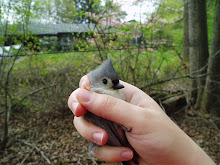 Beatrice was truly an exquisite little creature. She is surely gone to the great garden in the sky now, but she lived in a tank (ok, actually a file box) in our apartment for three days last October.
Beatrice was truly an exquisite little creature. She is surely gone to the great garden in the sky now, but she lived in a tank (ok, actually a file box) in our apartment for three days last October.
For my insect anatomy & physiology class, we had to collect some insects for dissection. I had already caught more than I needed (I still have some of the insects I didn't use in a jar on my desk, to remind me not to take life needlessly) when I found Beatrice hiding in a tangle of vines.
 She was so astonishingly beautiful (even if her kind is an invasive species) that I knew I couldn't let my classmates find her. I borrowed a jar to keep her in and brought her home with me instead.
She was so astonishingly beautiful (even if her kind is an invasive species) that I knew I couldn't let my classmates find her. I borrowed a jar to keep her in and brought her home with me instead. I tried to make her comfortable in a file box full of plant matter. (She coordinated with it beautifully.) I fed her whatever insects I could. Strangely, although we almost never get insects besides fruit flies in our apartment, while Beatrice was with me I found two large shield bugs on the screen door to our balcony. I fed both of them to her. She seemed to like them.
I tried to make her comfortable in a file box full of plant matter. (She coordinated with it beautifully.) I fed her whatever insects I could. Strangely, although we almost never get insects besides fruit flies in our apartment, while Beatrice was with me I found two large shield bugs on the screen door to our balcony. I fed both of them to her. She seemed to like them.Watching her eat was one of the most amazing things I have ever seen. (Including the time I saw a snake eat a mouse while hiking in New Mexico!) Mantids are ambush predators, so she would hold very very still and orient towards her prey, whether it was a stink bug, an injured satyr butterfly, or any of the other prey I supplied. Watching her triangular head turn to face her prey could have been science fiction. Once she was within striking distance, her forelegs would shoot out, delivering a crushing blow with the sharp spines on the inside of the grasping section. Then she would eat.
I could write poetry about the delightfulness of insect mouthparts. Humans are so limited. We have a single jaw that goes up and down. With a little thought we can go side to side, a bit. And that's it. Insect mouthparts are derived from appendages, which is why they come in pairs. Several pairs, actually. In addition to the mandibles, which are often the most visible, they have several other pairs that taste the food, help process it, and push it into the opening of the mouth. They are complex, tiny, and fascinating to watch.
Mantids are what we technically call "chewing" predators, which is to say, they eat the whole damn thing, exoskeleton and all. ("Sucking" predators turn the insides of their prey to soup and suck it out through straw-like mouthparts, discarding the exoskeleton when they finish; the true bugs do this.) Beatrice took dainty little bites (owing to her mouth being relatively small for her body) but she was certainly quick. Watching her eat a caterpillar reminded me of how I would approach a baguette, if no one was looking: hold it in both hands, take a big bite out of the middle, and eat through the middle first. Chew up one side until it was gone, then the other. Lick fingers.
Beatrice was as fastidious as a cat. After eating, she would meticulously groom every spine on her grasping legs. She even cleaned her eyes at one point (possibly after the butterfly, which no doubt covered her in little wing scales).
Eventually I felt that I couldn't keep Beatrice indoors any longer -- not when October was continuing in such glorious fashion. I returned to the garden when we first met and set her down on a patch of flowers, knowing that visiting bees and butterflies would supply her with plenty of food. I wanted her to live out her last week or two in her natural habitat, so that next spring there will be more baby mantids out there to find.




1 comment:
I love the mantids, and those are some nice pix.
Your description of Beatrice's hunting behavior reminds me of how my chameleons would behave when we fed them little grasshoppers. They were especially interesting to watch because of the independently swiveling eye-turrets. They would slowly approach, one eye would "lock on", then the other would come about (just about the only time their eyes would look in the same direction), and then BAM! the tongue lashes out and then they're munching.
Post a Comment